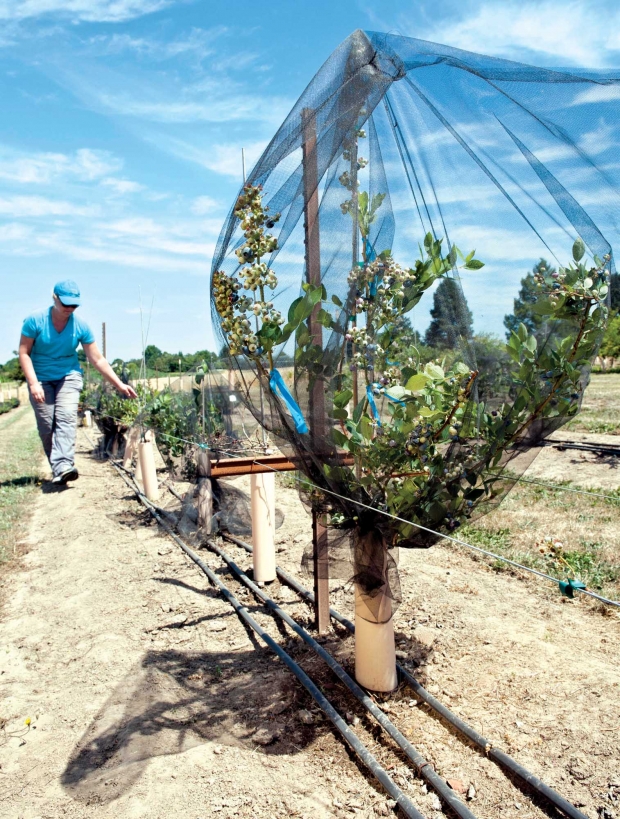
Grafted blueberry trees in test plots at Oregon State University’s North Willamette Research and Extension Center in Aurora, Oregon. (Courtesy Lynn Ketchum/Oregon State University)
Would a blueberry tree be better than a blueberry bush?
Oregon State University researcher Wei Qiang Yang has a couple of reasons to think so.
First, he says, in machine harvest of blueberry bushes, 15 to 20 percent of the berries are lost. The catch plates that collect the blueberries as they fall after being shaken free can’t close tightly around the multiple stems of bushes, so many of the berries simply drop to the ground. The plates could close better around a single stem.
Second, blueberries now grow on their own roots. To grow blueberries on trunks would require grafting them to rootstocks, and rootstocks could be bred and selected for important traits, such as nutrient uptake efficiency, tolerance to soilborne diseases, and high soil pH.
Yang, who is both a researcher and an extension agent in Oregon’s major blueberry production region around the North Willamette Research and Extension Center in Aurora where he works, has tested grafted blueberry trees that grow on single stems since 2005.
Sparkleberry
In a telephone interview with Good Fruit Grower, Yang said he first saw blueberry trees in eastern Texas, where a hobbyist had grafted a southern rabbiteye blueberry variety onto a wild-growing native blueberry, called a sparkleberry.
In the wild, some sparkleberry plants grow on a single stem to heights of up to ten feet. But their tiny berries are full of seeds and the fruit has a bad taste, Yang said.
Yang obtained sparkleberry seeds, grew them, and then grafted highbush blueberry scions from Liberty, Aurora, and Draper varieties onto the wild-growing plants. He now has a research plantation of blueberry trees.
Grafting
“There are 180 grafted blueberry trees (30 each of six cultivars) and 180 blueberry bushes, so I can compare them side by side in the field scientifically,” he said. “The plant spacing for the blueberry tree is three feet apart between plants and ten feet between the planting rows with grass middles. They are all planted on flat ground, no raised beds.”
So far, yields from the Aurora and Draper trees have been equal to those from bushes, but Liberty trees have lagged behind. Taste of the berries has not been affected by the rootstock.
Yang is collaborating with researchers at land-grant universities in California and Florida as part of a multistate effort. All are testing several blueberry varieties grafted onto rootstocks. Yang himself has a rootstock testing plot with more than 800 rootstock seedlings.
“We are the first to evaluate blueberry rootstocks for commercial use,” he said of the project.
Though some people have tried grafting blueberry trees on a small scale in the past, Yang said this is the first major collaborative research effort to graft a blueberry tree that is viable for commercial growers. Grafting itself is not difficult, he said.
“Right now, we are just trying to prove the concept,” he said. “There are no commercial rootstocks for
blueberries now.”
This is the first year researchers collected data on yield for the project in Oregon. Yang is still analyzing data on fruit quality factors such as firmness, size, and total acidity. He will investigate future yield projections and machine-harvesting potential next.
In eastern Texas, where Yang first saw grafted blueberry trees, they grew as tall as 14 feet, had trunks four to five inches in diameter, and were planted at a spacing of eight by eight feet. For commercial use, they would be better planted into fruiting walls kept to a height of about eight feet with ten feet between rows, he thinks.
With blueberry bushes, renewal pruning is used in which older canes are removed and new growth comes up from the ground. It is not clear how trees would need to be pruned. Top and side hedging would likely be tried, Yang said.
As for rootstocks, he thinks they could be chosen for tolerance of high pH soils. Blueberries like acidic soils, optimum being about 4.8. Some varieties, such as Duke, have problems with root rots, and rootstocks could address disease resistance as well.
Perfect climate
Blueberry production has been increasing in the Pacific Northwest, where they are grown in arid conditions with irrigation. “The climate here is perfect,” Yang said. The Oregon climate is moderate, so both northern highbush and southern rabbiteye varieties can be grown.
Last year, Oregon produced about 72 million pounds on about 8,000 acres. Acreage has tripled since 2000. Michigan, the leading blueberry producer, generated 82 million pounds from lower-yielding plantations covering almost 20,000 acres. In both states, about half the berries are grown for fresh market and most of those are picked by hand. The other half, grown for processing, are picked by machine, but machine harvest is making inroads gradually for fresh market as well.
Yang said that if results continue to show promise, blueberry trees could be ready for release to nurseries in about five years. •






I would love to see an update on this research project!